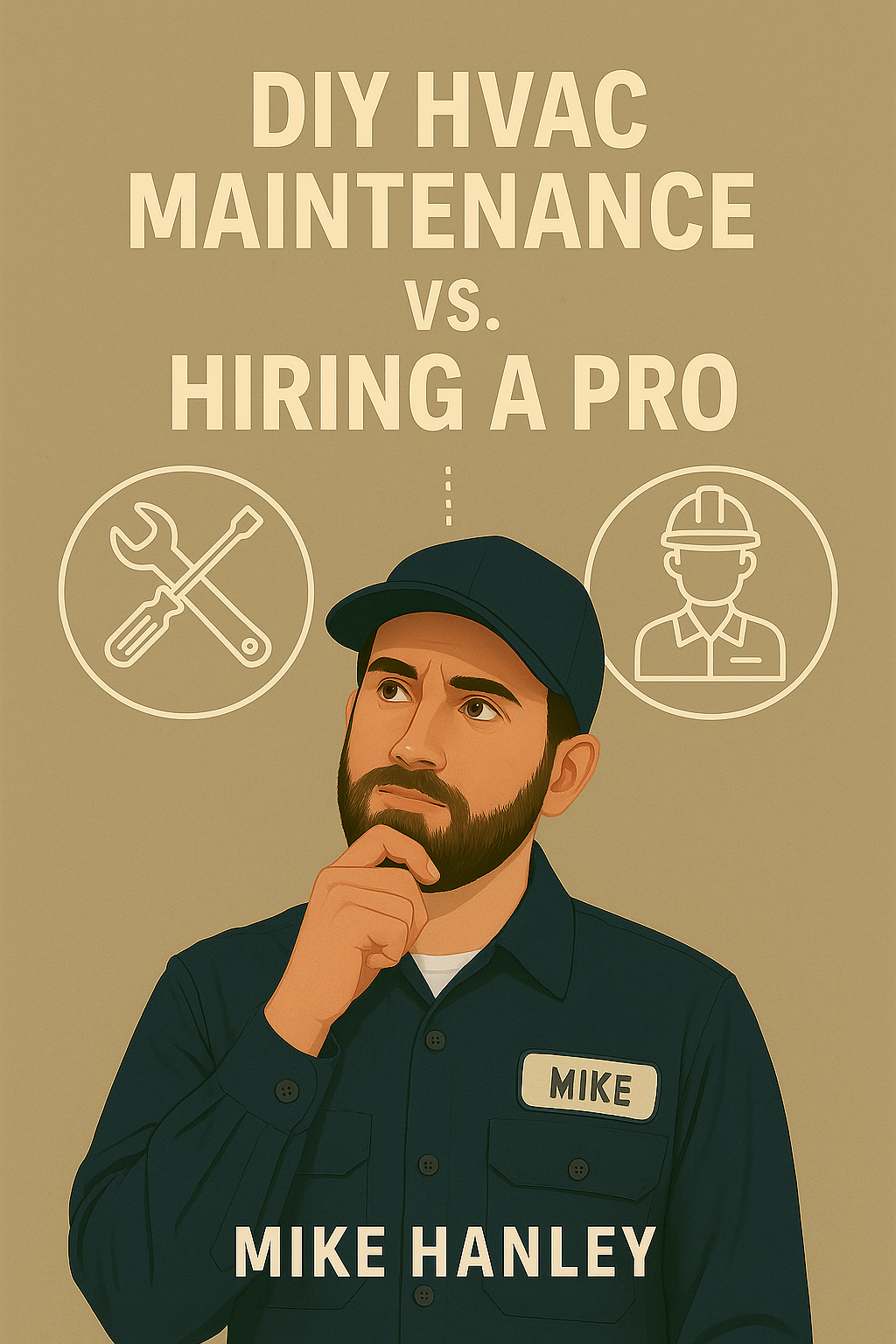📘 Table of Contents
💡 Why Choosing the Right Approach Matters
Your HVAC system represents a $5,000-12,000 investment that directly impacts your family's comfort, health, and budget. Understanding which maintenance tasks you can safely handle, and which require professional expertise, is crucial for system longevity and safety.
The Occupational Safety and Health Administration (OSHA) identifies HVAC work as requiring specialized training due to electrical, refrigerant, and combustion hazards. Let's clarify what's safe for homeowners and what's best left to professionals.
The stakes of proper maintenance:
-
DIY saves money and builds your knowledge
-
Professional care ensures safety, warranty compliance, and longer system life
-
The right balance protects your comfort, budget, and equipment
HVAC365 explains that combining DIY and experienced tech support helps you balance cost savings with expert backup to maintain system performance.
🛠 DIY Maintenance: What You Can Safely Do
These tasks require no special tools or certifications and significantly impact system performance:
🔄 Filter Changes & Register Cleaning
The most impactful DIY maintenance task, responsible for preventing 80% of system problems.
Safe DIY steps:
-
Change filters monthly or per our Filter Replacement Schedule
-
Vacuum supply and return vents quarterly
-
Remove vent covers annually for deep cleaning
-
Ensure furniture maintains 12" clearance from vents
🧹 Clean Outdoor Equipment
Your condenser needs breathing room to operate efficiently. The Department of Energy confirms that proper clearance can improve efficiency by 10%.
DIY condenser care:
- Turn off power at the disconnect box AND the circuit breaker
- Remove debris within a 2-foot radius
- Trim vegetation, maintaining 24" clearance
- Gently rinse fins with garden hose (not pressure washer)
- Straighten bent fins with a butter knife
🌡️ Thermostat Check & Battery Swap
Smart thermostats from our thermostat collection can reduce HVAC runtime by 23% through intelligent scheduling.
DIY thermostat tasks:
-
Test accuracy against a separate thermometer
-
Replace batteries before the heating/cooling season
-
Clean housing with compressed air
-
Update the programming seasonally
-
Enable maintenance reminders
💧 Condensate Drain Cleaning
Prevent water damage and mold growth with quarterly drain maintenance:
- Locate drain line (PVC pipe near indoor unit)
- Pour 1 cup white vinegar down the drain
- Flush with water after 30 minutes
- Check the drain pan for standing water
🏢 When to Call in the Pros
Some tasks require EPA certifications, specialized tools, and extensive training. Never attempt these yourself:
⚡ Electrical Work
According to the National Fire Protection Association, electrical issues cause 13% of home fires.
Leave to professionals:
-
Capacitor testing/replacement
-
Control board diagnostics
-
Motor replacements
-
Breaker or disconnect work
-
Any work inside electrical panels
🧊 Refrigerant Handling
EPA Section 608 requires certification for anyone handling refrigerants. Violations carry fines up to $44,539 per day.
Professional only:
-
Checking refrigerant levels
-
Repairing refrigerant leaks
-
Recovering or adding refrigerant
-
Replacing refrigerant components
🔥 Combustion System Work
Carbon monoxide poisoning affects 50,000 Americans annually, per the CDC.
Requires professional service:
-
Heat exchanger inspection
-
Gas pressure adjustments
-
Burner cleaning/adjustment
-
Venting system modifications
-
Carbon monoxide testing
💰 Cost & Value Comparison: DIY vs. Professional
|
Maintenance Task |
DIY Estimated Cost |
Professional Cost |
|
Filter + basic cleaning |
$0–$50 |
Included in visit |
|
Seasonal condenser prep |
$10–$30 |
Included |
|
Full tune-up & safety checks |
N/A |
$100–$300 per visit |
DIY cuts year-round costs, but skipping professional tasks can lead to failed motors or wasted energy costly over time.
The Building Performance Institute calculates:
- Average annual savings from DIY tasks: $200-400
- Cost of one DIY mistake requiring pro repair: $500-2,000
- System replacement due to neglect: $5,000-12,000
✅ Best of Both Worlds: A Hybrid Approach
The most effective strategy combines DIY diligence with professional expertise:
📅 Optimal Maintenance Calendar
Monthly (DIY):
- Check/replace filters
- Visual inspection of equipment
- Clear debris from outdoor unit
- Monitor thermostat operation
Quarterly (DIY):
- Clean supply/return vents
- Clear condensate drain
- Test all safety switches
- Document any changes in performance
Annually (Professional):
- Comprehensive system inspection
- Professional cleaning and adjustment
- Safety testing and certification
- Warranty-compliant documentation
📝 Maintenance Agreements
Consider a professional maintenance agreement that includes:
- Priority emergency service
- Discounts on repairs (typically 10-20%)
- No overtime charges
- Transferable coverage (adds home value)
- Extended warranties
This model maximizes savings and keeps your system healthy, exactly what precision-maintenance experts recommend.
🔗 Final Thoughts by Mike Hanley
DIY maintenance is smart for filters and cleaning, but HVAC systems contain components best left to certified techs.
Combine regular home upkeep with seasonal professional check-ins, and you'll enjoy a reliable system, better indoor comfort, and fewer repair surprises.
-
🔙 Previous: HVAC Filter Replacement Schedule
-
🛒 Ready to Upgrade?
👉 Back to main topic: How to Maintain Your HVAC System for Maximum Lifespan
❓ FAQ
Q: Is it safe to clean condenser coils myself?
A: Yes, if you turn off power and use gentle cleaning tools. Rinse carefully to avoid damaging fins .
Q: How often should I have a pro visit?
A: Twice a year is ideal: spring for cooling, fall for heating. This matches DOE guidance for maintaining efficiency .
Q: Why do pro services cost so much more than DIY?
A: Technicians use calibrated tools and perform detailed safety checks, including refrigerant handling, combustion analysis, and precise electrical testing .
Q: Can DIY void my warranty?
A: Possibly, many warranties require licensed technician records. DIY filter changes are fine, but don't skip professional visits.







